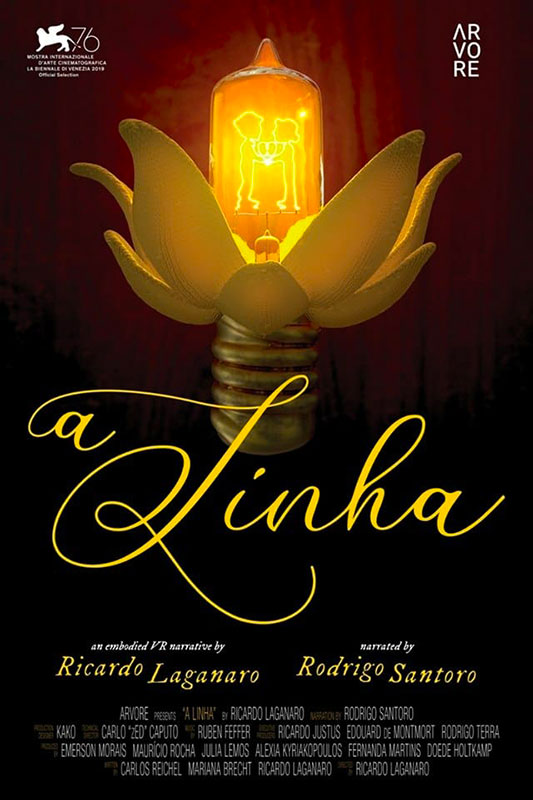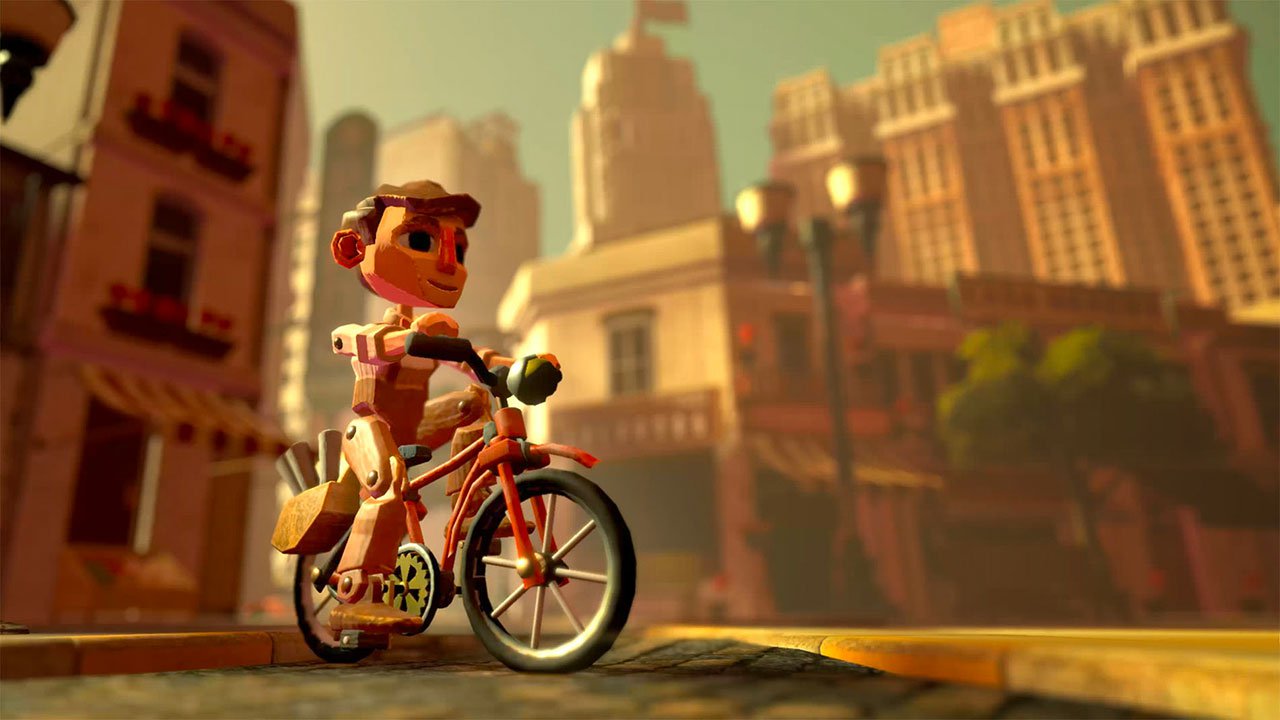When you read something as a child you do not only enjoy a story. Everything about it comes to life around you: the voices, the sounds, the smells, the colors, even the tastes. There is no separation between your imagination and what is on that book and it feels almost… magical. And “magical” is the perfect word to describe A LINHA. An Arvore production directed by Ricardo Laganaro, A LINHA (THE LINE) was presented at the VeniceVR of the 76th Venice Film Festival, where it won the Best VR Experience Award.
An installation I immediately fell in love with, because it brought back that childlike way of “enjoying” things. And even in VR, where dreams often come true, it is rare to find works that can convey such a strong, but somehow innocent, feeling.
We talked with his director, Ricardo Laganaro, after the Tribeca Film Festival announced the selection of A LINHA for its Virtual Arcade category . Here’s what he told us.

About narrative content in VR
Ricardo Laganaro – We created A LINHA because we thought there was still a big open space for narrative content in VR, mainly for an audience that is not familiar with the medium, nor is into new technologies. We wanted to create a more mainstream experience that would show the potential of immersive narratives even to people who believe VR will never be a thing for them. So, on the storytelling side, our first approach was to create a fable. A simple and beautiful love story that everyone would understand, but that also dealt with deeper issues like fear of change and being stuck in a routine, which are themes that everyone can relate to on a deeper level.
R. L. – Another thing that I was curious about, as a creator, was the idea of creating a simple love story using this new medium. Before A LINHA I directed social impact documentaries, spectacular immersive videos in space and inside Supernovas and all the kind of content that feels already adapted to VR. But what about the ordinary stories in places that we know and like? I think VR also needs those beautiful and simple stories to become more popular.
R. L. – Also, there is one unexpected and very good side effect of VR for me, and that is the fact that we are bringing our entire body to the center of the intellectual experience again. In VR we do not need to stay still to enjoy a good story. We can move around, interact with the world we are entering, and physically feel that we own that story. And I was very curious to see a love story in a setup like that.
Storytelling and technology in A LINHA
R. L. – I have been working with immersive content since 2012. The first thing I painfully learned from the first project, is that it is impossible to write a script first and then produce the content, as if they were distinct phases of the process. From the technology to the language of the medium, everything is developing so fast that the writing process should be integrated with them throughout the entire production.
R. L. – When I became a partner at ARVORE in Brazil, we spent 18 months experimenting with different workflows and frameworks to better understand how to create this integration.
R. L. – To start a production, we always need to create a first draft as fast as possible, so everyone in the team can see the same thing and discuss it. This happens even before concept arts. At this stage, everything is very raw, and we even do live-action prototypes.
R. L. – For A LINHA we used cardboard boxes, white tapes, post-its, and small action figures. The narrative designer read the script and one of the team members was role-playing as the user. By doing that, we could work more quickly at the script, understand the geography of the scenery and even predict which interactions would work better. We kept creating prototypes to develop the idea. We also used gray-box blocking in VR with very simple interactions as a horizontal lo-fi slice of the entire experience. After that, we created a hi-fi vertical slice of a small part of the experience, to set the quality bar for all the areas (narrative, systems, and art). Each one of these versions was tested with users to help us create better versions of the story.
R. L. – This all can sound a little bit too techie, but when the creative process is user-oriented, iterative and incremental, we are able to refine the experience during the production process and reduce all friction. So, people will just remember the story. We have a saying at ARVORE: “If people take the headset off and talk about VR, we failed”. We want them to forget the technology and remember the story and the emotions they felt.

The audience at the Venice Film Festival
R. L. – I learn a lot by watching people making my experiences. And it is also very rewarding to see people enjoying them.
R. L. – One thing I find funny is that at the beginning of A LINHA people are still very aware of the fact that they are in a VR experience. So, they tend to ask what they can do or not, test everything in the virtual space, or talk to a friend who is outside the experience. But as the story unravels, they begin to respect its pace and completely forget the world outside. Usually, they take the headset off and they are in a different “frequency”. Calmer, happier.
R. L. – Another thing I really like is that we teach the user to move and interact with the virtual scale model to make the story go forward, but in one of the most exciting moments, Pedro, one of the lead characters, has to learn to move by himself. This is a moment when people cannot interact with the experience at all, and some of them get almost desperate to help him. When I see this happening, I know that that person is 100% engaged with the characters and the story.
R. L. – At the beginning of the event in Venice, we were trying to figure out if the experience was working well. But one thing that moved me a lot in the second week was to see people from all parts of the globe crying and getting very emotional with our story. In Brazil, we are experiencing a delicate moment regarding the appreciation of art and culture, so being this appreciated from people all over the globe, literally, is very important and touching to me, now.
The future: western countries and Asia
R. L. – A LINHA can be a good way to make more people love our medium. Our goal is to make as many people as possible try it.
R. L. – On the LBE side, it was already very hard to distribute globally. With everything that is happening in the world, it will be even harder. But we are talking with good partners in different countries and we want to make it possible to exhibit our piece everywhere when the world will find a new normality.
R. L. – We already had great exhibitions in France and Luxembourg, and there are plenty of talks in other countries, including Asia. In Venice, I had a lot of great feedback from the Chineses, the South Koreans and the Japaneses. It would be a dream to see our piece in all Asia, besides all the western countries.
R. L. – Another important step will be the home-use version. We are working hard to port A LINHA to Oculus Quest and launch it for everyone as soon as possible. I hope our piece will give people nice and warm feelings in these difficult times.
About the Tribeca Film Festival
R. L. – I’m very proud and happy to have our piece selected for Tribeca. Their curatorship for the Virtual Arcade is very impressive every year! And, besides, I have a deeply personal connection with this festival, since it was the first international event that selected “Step To the Line”, my first VR documentary.

R. L. – We really wanted to present A LINHA to the American audience in the best possible way, and when we knew that Tribeca selected us, we were sure that it would be the right place to be. Unfortunately, we will not be able to show A LINHA at the virtual edition of the festival they are putting on with Oculus (link). This initiative is amazing! However, they will be able to show only the line-up of the “360º Cinema”. So all the interactive pieces at the Virtual Arcade, like ours, will not be shown there.



Leave a Reply
You must be logged in to post a comment.